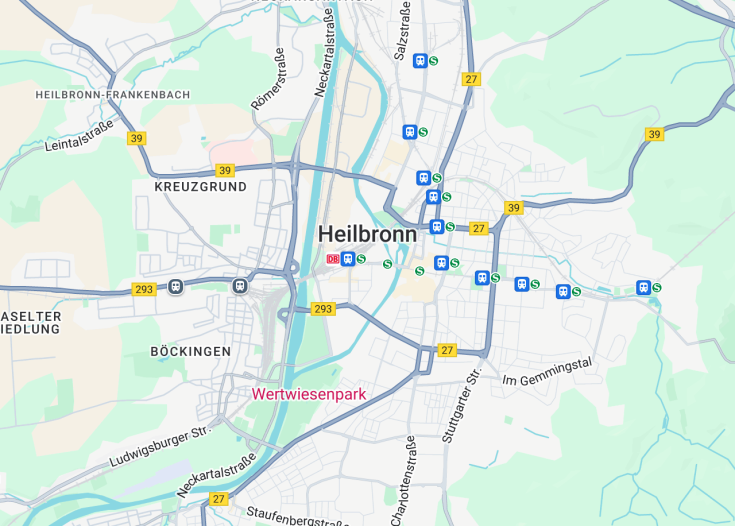Nestled in the enchanting region of Baden-Württemberg, Heilbronn is a gem waiting to be discovered by avid travelers seeking a blend of history and modernity. Known as the “City of Wine,” Heilbronn offers an appealing mix of scenic vineyard landscapes, historical architectures such as the Gothic St. Kilian’s Church, and vibrant cultural festivals. This city not only captivates with its picturesque setting on the Neckar River but also with its rich history and thriving economy, making it an ideal destination for both leisure and educational trips.
When visiting Heilbronn, a must-do is to explore the wine trails around the city; they offer picturesque views and a taste of local vineyard culture.
Plan your visit during the summer to participate in the Heilbronner Weindorf, a festival that celebrates local wines and provides a festive atmosphere.
Top things to do & see in Heilbronn
Select the following sights and activities to discover best tickets and tours available in Heilbronn.
Heilbronn: A Gem in Southwestern Germany
| Country | Germany |
| Time in Heilbronn | GMT+2 |
| Language spoken | German |
| Population | 126,592 (source: latest municipal data) |
| Currency | Euro (€, EUR) |
| Airports |
|
Located in the picturesque southwest of Germany, Heilbronn is a city steeped in history and culture. Known as a major wine-growing region, the city’s charm is accentuated by its scenic landscapes, vibrant vineyards, and historic architecture. Heilbronn first achieved prominence due to its strategic location on the Neckar River, playing a vital role as a trading hub in the medieval period. Today, it’s renowned not only for its beautiful surroundings and rich heritage but also for its contribution to industry and education, housing leading companies and educational institutions.
Where is Heilbronn?
Heilbronn is situated in the state of Baden-Württemberg, nestled between Stuttgart and Mannheim along the Neckar River.
Distances:
| Route | Distance by car | Time by car |
|---|---|---|
| Stuttgart to Heilbronn | 31 miles (50 km) | About 45 minutes |
| Mannheim to Heilbronn | 56 miles (90 km) | About 1 hour |
| Frankfurt to Heilbronn | 98 miles (158 km) | About 1 hour 30 minutes |
What is Heilbronn famous for?
Heilbronn is especially famed for its thriving wine industry, a tradition that dates back hundreds of years. Its picturesque landscapes dotted with vineyards make it a popular destination for enthusiasts and tourists alike.
History
Before 741 AD: Early Settlements
Heilbronn’s story begins long before written records were established. Archaeological findings suggest that the area was inhabited in prehistoric times, playin crucial roles during various epochs.The land around the Neckar river, where Heilbronn sits, was fertile and appealing to early settlers whose remnants indicate a blend of agrarian and early urban development.
741 AD-1500: Foundation and Medieval Times
Heilbronn was officially mentioned for the first time in a document dating back to 741 AD, suggesting early settlements that evolved under the influence of the Holy Roman Empire. By the 12th century, it gained city rights, leading to an acceleration in its growth and importance. The 14th and 15th centuries saw Heilbronn becoming a significant player in the trading networks, promoting wine cultivation which became a cornerstone of the regional economy.
1500-1800: Renaissance and Reformation
The Renaissance and Reformation periods brought economic prosperity and cultural flowering to Heilbronn. The city endured through the Thirty Years’ War, although facing significant devastations. The rebuilding efforts laid the foundations for modern developments.
1800-1945: Industrialization and World War Impact
Entering the industrial age, Heilbronn became notable for its machine building and metalworking industries. The strategic location along with significant industrial capabilities made the city a target during World War II, leading to severe bombings that reshaped much of the cityscape. Post-war rebuilding efforts focused on modern architecture and restoring economic stability.
1945-Present: Regeneration and Modern Times
The post-war era marked a period of regeneration and modernization for Heilbronn. It evolved into a thriving economic hub highlighted by technological advancements and educational growth, with institutions like the Hochschule Heilbronn fostering innovation. The integration of traditional industries with modern technology maintains Heilbronn’s reputation as a dynamic city well into the 21st century.
Visit Heilbronn
What to see and do in Heilbronn
Heilbronn offers an enriching blend of historical and contemporary attractions:
- The Kilianskirche, a magnificent church that showcases Gothic architecture.
- The Experimenta Science Center, a modern facility engaging with interactive science exhibits.
- Stroll along the Neckar River for picturesque views and relaxing settings.
Explore the Heilbronn Path, a guided tour that narrates city’s rich history while highlighting its vibrant modernity.
Annual Celebrations and Events
Heilbronn hosts a variety of cultural and traditional events throughout the year:
- The Heilbronn Wine Festival in September celebrates local viticulture.
- The Gaffenberg Festival, a summer music event offering diverse genres.
These festivities reflect Heilbronn’s rich heritage and lively local culture.
Best time to visit Heilbronn
Spring and early autumn are ideal for visiting Heilbronn when the weather is pleasant and the city’s parks and vineyards are especially inviting. The wine festival in September particularly highlights the city’s vibrant community spirit.
Is Heilbronn worth visiting?
Heilbronn is undoubtedly worth visiting for those who appreciate a rich historical tapestry intertwined with modern innovation. The city offers a unique blend of cultural heritage, educational facilities, and green spaces, making it an appealing destination for tourists and scholars alike.















